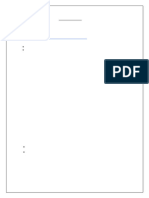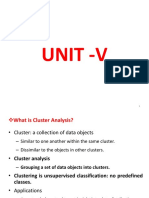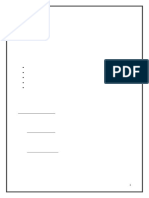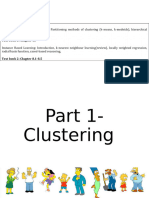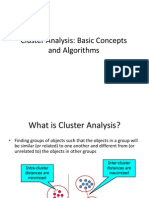0 ratings0% found this document useful (0 votes)
37 viewsClustering in Python
Uploaded by
aman38402Copyright
© © All Rights Reserved
Available Formats
Download as PPTX, PDF, TXT or read online on Scribd
0 ratings0% found this document useful (0 votes)
37 viewsClustering in Python
Uploaded by
aman38402Copyright
© © All Rights Reserved
Available Formats
Download as PPTX, PDF, TXT or read online on Scribd
You are on page 1/ 31
Clustering in Python
Vijay Kumar Dwivedi
Clustering: Concept
• Given a set of records (instances, examples,
objects, observations, …), organize them into
clusters (groups, classes)
• Clustering: the process of grouping physical or
abstract objects into classes of similar objects
What is a Cluster?
• A cluster is a subset of objects which are
“similar” .
• A subset of objects such that the distance
between any two objects in the cluster is less
than the distance between any object in the
cluster and any object not located inside it.
• A connected region of a multidimensional
space containing a relatively high density of
objects
What is Clustering?
• Clustering is a process of partitioning a set of
data (or objects) into a set of meaningful sub-
classes, called clusters.
• Help users understand the natural grouping or
structure in a data set.
• Clustering: unsupervised classification: no
predefined classes.
• Used either as a stand-alone tool to get insight
into data distribution or as a preprocessing
step for other algorithms.
What is Good Clustering?
• A good clustering method will produce high
quality clusters in which:
– the intra-class (that is, intra-cluster) similarity is
high.
– the inter-class similarity is low.
• The quality of a clustering result also depends
on both the similarity measure used by the
method and its implementation.
• The quality of a clustering method is also
measured by its ability to discover some or all
of the hidden patterns.
• However, objective evaluation is problematic:
Clustering: Applications
• Economic Science (especially market research).
• WWW
– Document classification
– Cluster Weblog data to discover groups of similar
access patterns
• Pattern Recognition
• Spatial Data Analysis
• Image Processing
Main Categories of Clustering
• Methods
Partitioning algorithms: Construct various
partitions and then evaluate them by some
criterion
• Hierarchy algorithms: Create a hierarchical
decomposition of the set of data (or objects)
using some criterion.
• Density-based: based on connectivity and
density functions
• Grid-based: based on a multiple-level
granularity structure
• Model-based: A model is hypothesized for
each of the clusters and the idea is to find the
Partitioning Algorithms: Basic
Concept
• Partitioning method: Construct a partition of a
database D of n objects into a set of k clusters
• Given a k, find a partition of k clusters that
optimizes the chosen partitioning criterion.
– Global optimal: exhaustively enumerate all
partitions.
– Heuristic methods: k-means and k-medoids
algorithms.
– k-means (MacQueen’67): Each cluster is
represented by the center of the cluster
– k-medoids or PAM (Partition around medoids)
(Kaufman & Rousseeuw’87): Each cluster is
represented by one of the objects in the cluster.
Simple Clustering: K-means
• Basic version works with numeric data only
• Pick a number (K) of cluster centers - centroids
(at random)
• Assign every item to its nearest cluster center
(e.g. using Euclidean distance)
• Move each cluster center to the mean of its
assigned items
• Repeat steps 2,3 until convergence (change in
cluster assignments less than a threshold)
Illustrating K-Means: Working
KMeans: Numerical Example
• Cluster the following eight points (with (x, y)
representing locations) into three clusters:
– A1(2, 10), A2(2, 5), A3(8, 4), A4(5, 8), A5(7, 5), A6(6,
4), A7(1, 2), A8(4, 9)
• Solution:
– Initial cluster centers are:
• A1(2, 10), A4(5, 8) and A7(1, 2). (Randomly chosen)
• Select cluster centers in such a way that they are as
farther as possible from each other.
– Calculate the distance between each data point and
each cluster center.
– The distance may be calculated either by using
given distance function or by using manhatan
distance formula.
• Calculating Distance Between A1(2, 10) and
C1(2, 10)-
– Ρ(A1, C1)== |x2 – x1| + |y2 – y1|
– = |2 – 2| + |10 – 10| = 0
• Calculating Distance Between A1(2, 10) and
C2(5, 8)-
• Ρ(A1, C2)= |x2 – x1| + |y2 – y1|
• = |5 – 2| + |8 – 10|= 3 + 2= 5
• Calculating Distance Between A1(2, 10) and
C3(1, 2)-
• Ρ(A1, C3)= |x2 – x1| + |y2 – y1|
• = |1 – 2| + |2 – 10|= 1 + 8= 9
• Similarly compute distance for remaining
Three Clusters are:
C1:A1(2, 10)
C2:
A3(8, 4)
A4(5, 8)
A5(7, 5)
A6(6, 4)
A8(4, 9)
C3: A2(2, 5), A7(1, 2)
Recompute New Cluster Center
The new cluster center is computed by taking mean of all
the points contained in that cluster.
We have only one point A1(2, 10) in Cluster-01.
So, cluster center remains the same.
For Cluster-02:
Center of Cluster-02
= ((8 + 5 + 7 + 6 + 4)/5, (4 + 8 + 5 + 4 + 9)/5)= (6, 6)
For Cluster-03:
Center of Cluster-03:
= ((2 + 1)/2, (5 + 2)/2)= (1.5, 3.5)
Iteration 2
Again compute distance of all points with
newly computed cluster centers
C1(2,10), C2(6,6), C3(1.5,3.5)
After second Iteration, the cluster centers
are:
C1(3, 9.5)
C2(6.5, 5.25)
C3(1.5, 3.5)
This process is continued until the
assignment of any point remains changing
to new clusters
Kmeans: Advantages
Kmeans: Disadvantages
Choosing K manually
Being dependent on initial values.
Clustering data of varying sizes and
density.
Clustering outliers.
Scaling with number of dimensions.
K-means Clustering
• Importing K-means
– from sklearn.cluster import Kmeans
• #Loading Data Set
– df=pd.read_csv('iris.csv')
• Extracting columns
– X=df[['sepal_length','sepal_width']]
– Y=df['species']
• Creating K-Means based Clustreing Model
• kmeans = KMeans(n_clusters=3,
random_state=0).fit(X)
K-means Clustering Contd…
• Printing Clustering Centroids
– print(kmeans.cluster_centers_)
• # Get the cluster labels
– print(kmeans.labels_)
• # Plotting the cluster centers and the data
points on a 2D plane
– plt.scatter(X['sepal_length'], X['sepal_width'])
– plt.scatter(kmeans.cluster_centers_[:, 0],
kmeans.cluster_centers_[:, 1], c='red', marker='x')
– plt.title('Data points and cluster centroids')
– plt.show()
K-Means Clustering Contd…
• Checking Accuracy using silhouette_score
– from sklearn.metrics import silhouette_score
– print(silhouette_score(X, kmeans.labels_))
Hierarchical Clustering: Agglomerative
In this technique, initially each data point is
considered as an individual cluster.
At each iteration, the similar clusters merge
with other clusters until one cluster or K
clusters are formed.
Hierarchical Clustering: Agglomerative
The basic algorithm of Agglomerative is as
follows:
Compute the proximity matrix
Let each data point be a cluster
Repeat: Merge the two closest clusters and
update the proximity matrix
Until only a single cluster remains
Hierarchical Clustering: Agglomerative Example
Hierarchical Clustering: Agglomerative Example
Hierarchical Clustering:
Visualization
The Hierarchical clustering Technique can
be visualized using a Dendrogram.
A Dendrogram is a tree-like diagram that
records the sequences of merges or splits.
Agglomerative Clustering
• Importing Packages
– import scipy.cluster.hierarchy as shc
– from sklearn.cluster import AgglomerativeClustering
• Plotting Dendograms
– dend = shc.dendrogram(shc.linkage(X,
method='ward'))
• Creating Model
– cluster = AgglomerativeClustering(n_clusters=5,
affinity='euclidean', linkage='ward')
Agglomerative Clustering Contd…
• Performing Predictions
– cluster.fit_predict(X)
• Plotting Clusters
– plt.scatter(X['sepal_length'], X['sepal_width'],
c=cluster.labels_, cmap='rainbow')
You might also like
- Unit 4 Clustering - K-Means and HierarchicalNo ratings yetUnit 4 Clustering - K-Means and Hierarchical40 pages
- 6.nsupervised Learning Clustering Lecture 7 Slides For4962No ratings yet6.nsupervised Learning Clustering Lecture 7 Slides For496237 pages
- Jaipur National University: Project Design With Seminar100% (1)Jaipur National University: Project Design With Seminar26 pages
- Clustering Techniques - Hierarchical, K-Means ClusteringNo ratings yetClustering Techniques - Hierarchical, K-Means Clustering22 pages
- What Is Cluster Analysis?: - Cluster: A Collection of Data ObjectsNo ratings yetWhat Is Cluster Analysis?: - Cluster: A Collection of Data Objects42 pages
- Presentation: Operating System Concept CS-582No ratings yetPresentation: Operating System Concept CS-58213 pages
- CLUSTERING CLASSIFICATION AND INTRO NEURAL NETWORKNo ratings yetCLUSTERING CLASSIFICATION AND INTRO NEURAL NETWORK168 pages
- CC282 Unsupervised Learning (Clustering) : Lecture 7 Slides For CC282 Machine Learning, R. Palaniappan, 2008 1No ratings yetCC282 Unsupervised Learning (Clustering) : Lecture 7 Slides For CC282 Machine Learning, R. Palaniappan, 2008 138 pages
- Data Mining: I Gede Mahendra DarmawigunaNo ratings yetData Mining: I Gede Mahendra Darmawiguna25 pages
- ML Application in Signal Processing and Communication EngineeringNo ratings yetML Application in Signal Processing and Communication Engineering27 pages
- 6 - Machine Learning and Unlabeled DataNo ratings yet6 - Machine Learning and Unlabeled Data67 pages
- DATA MINING and MACHINE LEARNING: CLUSTER ANALYSIS and kNN CLASSIFIERS. Examples with MATLABFrom EverandDATA MINING and MACHINE LEARNING: CLUSTER ANALYSIS and kNN CLASSIFIERS. Examples with MATLABNo ratings yet
- Relationship Between The Financial Literacy and Spending Habits of Grade 12 Iloilo National High School Students0% (1)Relationship Between The Financial Literacy and Spending Habits of Grade 12 Iloilo National High School Students8 pages
- The Phonology of Intonation and Phrasing 2006100% (2)The Phonology of Intonation and Phrasing 2006475 pages
- Analysis of Differences in Perception of Social Support in Public Spaces in The NeighborhoodNo ratings yetAnalysis of Differences in Perception of Social Support in Public Spaces in The Neighborhood22 pages
- Chinese Whisper Game As One Alternative Technique To Teach SpeakingNo ratings yetChinese Whisper Game As One Alternative Technique To Teach Speaking14 pages
- Written Assignment Unit 4 - Sara CrawfordNo ratings yetWritten Assignment Unit 4 - Sara Crawford2 pages
- Understanding Existing Buildings Five Studies To Complete Before Design Work StartsNo ratings yetUnderstanding Existing Buildings Five Studies To Complete Before Design Work Starts4 pages
- International Experts' Review Hydric Component of The Environmental Impact Assessment Conga Mining ProjectNo ratings yetInternational Experts' Review Hydric Component of The Environmental Impact Assessment Conga Mining Project264 pages
- Boresight Calibration of Mobile Mapping SystemsNo ratings yetBoresight Calibration of Mobile Mapping Systems10 pages
- The Impact of Sales Promotion Techniques On Consumer Purchase Decisions Within Community PharmaciesNo ratings yetThe Impact of Sales Promotion Techniques On Consumer Purchase Decisions Within Community Pharmacies4 pages
- Research Methods and Data Analysis in Psychology I: Welcome To PSYC 300No ratings yetResearch Methods and Data Analysis in Psychology I: Welcome To PSYC 30018 pages
- Acknowledgement: Survey Camp Report 2015No ratings yetAcknowledgement: Survey Camp Report 20155 pages
- Design and Policy Making - The Canvas For Social EconomyNo ratings yetDesign and Policy Making - The Canvas For Social Economy3 pages
- Impact of FMCG Promotion On Consumer Buying BehaviourNo ratings yetImpact of FMCG Promotion On Consumer Buying Behaviour6 pages
- Emotional Intelligence and Work Life Balance.: P.Shylaja, Dr. CH - Jayasankara PrasadNo ratings yetEmotional Intelligence and Work Life Balance.: P.Shylaja, Dr. CH - Jayasankara Prasad4 pages
- Teaching - Trainer - Cristiane Gonçalves PDFNo ratings yetTeaching - Trainer - Cristiane Gonçalves PDF15 pages
- Pd9211-Quality Concepts in Design-R8 PDFNo ratings yetPd9211-Quality Concepts in Design-R8 PDF2 pages
- 6.nsupervised Learning Clustering Lecture 7 Slides For49626.nsupervised Learning Clustering Lecture 7 Slides For4962
- Jaipur National University: Project Design With SeminarJaipur National University: Project Design With Seminar
- Clustering Techniques - Hierarchical, K-Means ClusteringClustering Techniques - Hierarchical, K-Means Clustering
- What Is Cluster Analysis?: - Cluster: A Collection of Data ObjectsWhat Is Cluster Analysis?: - Cluster: A Collection of Data Objects
- CLUSTERING CLASSIFICATION AND INTRO NEURAL NETWORKCLUSTERING CLASSIFICATION AND INTRO NEURAL NETWORK
- CC282 Unsupervised Learning (Clustering) : Lecture 7 Slides For CC282 Machine Learning, R. Palaniappan, 2008 1CC282 Unsupervised Learning (Clustering) : Lecture 7 Slides For CC282 Machine Learning, R. Palaniappan, 2008 1
- ML Application in Signal Processing and Communication EngineeringML Application in Signal Processing and Communication Engineering
- DATA MINING and MACHINE LEARNING: CLUSTER ANALYSIS and kNN CLASSIFIERS. Examples with MATLABFrom EverandDATA MINING and MACHINE LEARNING: CLUSTER ANALYSIS and kNN CLASSIFIERS. Examples with MATLAB
- Relationship Between The Financial Literacy and Spending Habits of Grade 12 Iloilo National High School StudentsRelationship Between The Financial Literacy and Spending Habits of Grade 12 Iloilo National High School Students
- Analysis of Differences in Perception of Social Support in Public Spaces in The NeighborhoodAnalysis of Differences in Perception of Social Support in Public Spaces in The Neighborhood
- Chinese Whisper Game As One Alternative Technique To Teach SpeakingChinese Whisper Game As One Alternative Technique To Teach Speaking
- Understanding Existing Buildings Five Studies To Complete Before Design Work StartsUnderstanding Existing Buildings Five Studies To Complete Before Design Work Starts
- International Experts' Review Hydric Component of The Environmental Impact Assessment Conga Mining ProjectInternational Experts' Review Hydric Component of The Environmental Impact Assessment Conga Mining Project
- The Impact of Sales Promotion Techniques On Consumer Purchase Decisions Within Community PharmaciesThe Impact of Sales Promotion Techniques On Consumer Purchase Decisions Within Community Pharmacies
- Research Methods and Data Analysis in Psychology I: Welcome To PSYC 300Research Methods and Data Analysis in Psychology I: Welcome To PSYC 300
- Design and Policy Making - The Canvas For Social EconomyDesign and Policy Making - The Canvas For Social Economy
- Impact of FMCG Promotion On Consumer Buying BehaviourImpact of FMCG Promotion On Consumer Buying Behaviour
- Emotional Intelligence and Work Life Balance.: P.Shylaja, Dr. CH - Jayasankara PrasadEmotional Intelligence and Work Life Balance.: P.Shylaja, Dr. CH - Jayasankara Prasad












